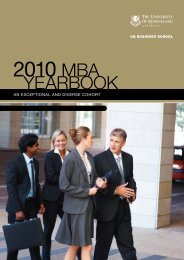Modelling the accruals process and assessing unexpected accruals*
Modelling the accruals process and assessing unexpected accruals*
Modelling the accruals process and assessing unexpected accruals*
Create successful ePaper yourself
Turn your PDF publications into a flip-book with our unique Google optimized e-Paper software.
change in net financial obligations, or directly calculated as net financing expenses minus non-<br />
equity financing cash flow.<br />
The reason why direct <strong>and</strong> indirect methods may result in different measures (in Hribar <strong>and</strong><br />
Collins 2002) is because <strong>the</strong> income used to calculate <strong>accruals</strong> under <strong>the</strong> direct method is not<br />
comprehensive. Dirty surplus items are by definition items that increase net assets <strong>and</strong> bypass <strong>the</strong><br />
income statements (Penman 2004). If <strong>the</strong>se items have been accounted for in <strong>the</strong> calculation of<br />
<strong>accruals</strong>, <strong>the</strong> direct <strong>and</strong> indirect methods will yield <strong>the</strong> same measure of <strong>accruals</strong>. For instance,<br />
had <strong>the</strong> impact of foreign currency translations been accounted for, a classic dirty surplus item, it<br />
would not lead to different measures of <strong>accruals</strong> under direct <strong>and</strong> indirect methods.<br />
The compliance of <strong>the</strong> clean surplus relation is not an assumption, but ra<strong>the</strong>r is simply a<br />
depiction of how accounting works. All clean surplus relations in section 2.1 reflect <strong>the</strong> basic<br />
accounting identity of Asset = Liability + Equity. A violation of <strong>the</strong> clean surplus accounting<br />
implies a violation of this basic accounting identity <strong>and</strong> a violation of <strong>the</strong> fundamental<br />
accounting premise that debits equal credits. For accounting to work, <strong>the</strong> clean surplus relation or<br />
identity, by definition, has to hold. The empirical evidence that is not in favor of clean surplus<br />
relation does not automatically reject its existence. It can simply be due to <strong>the</strong> lack of data items<br />
to comprehensively calculate <strong>the</strong> dirty surplus or non-articulation items. In short, <strong>accruals</strong> under<br />
<strong>the</strong> direct <strong>and</strong> indirect methods should be <strong>the</strong> same if appropriate adjustments are made to ei<strong>the</strong>r<br />
method in compliance with clean surplus relations or accounting identities.<br />
11



